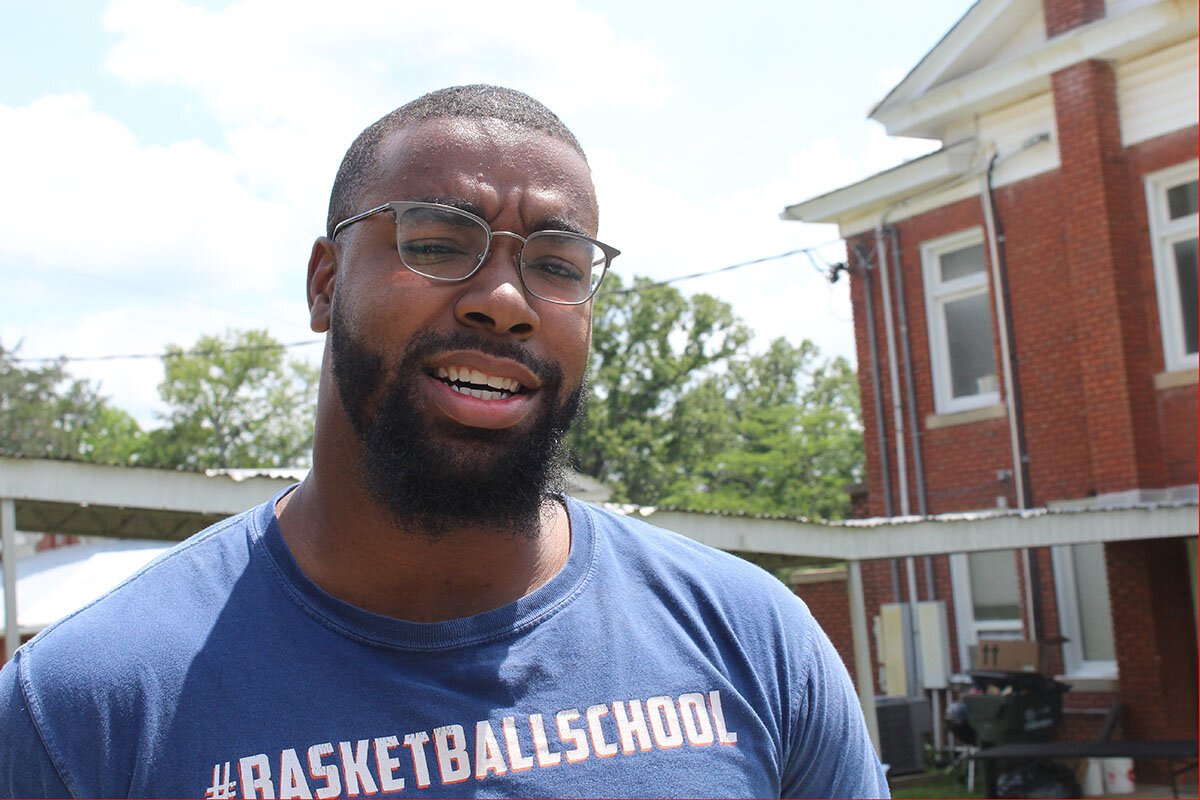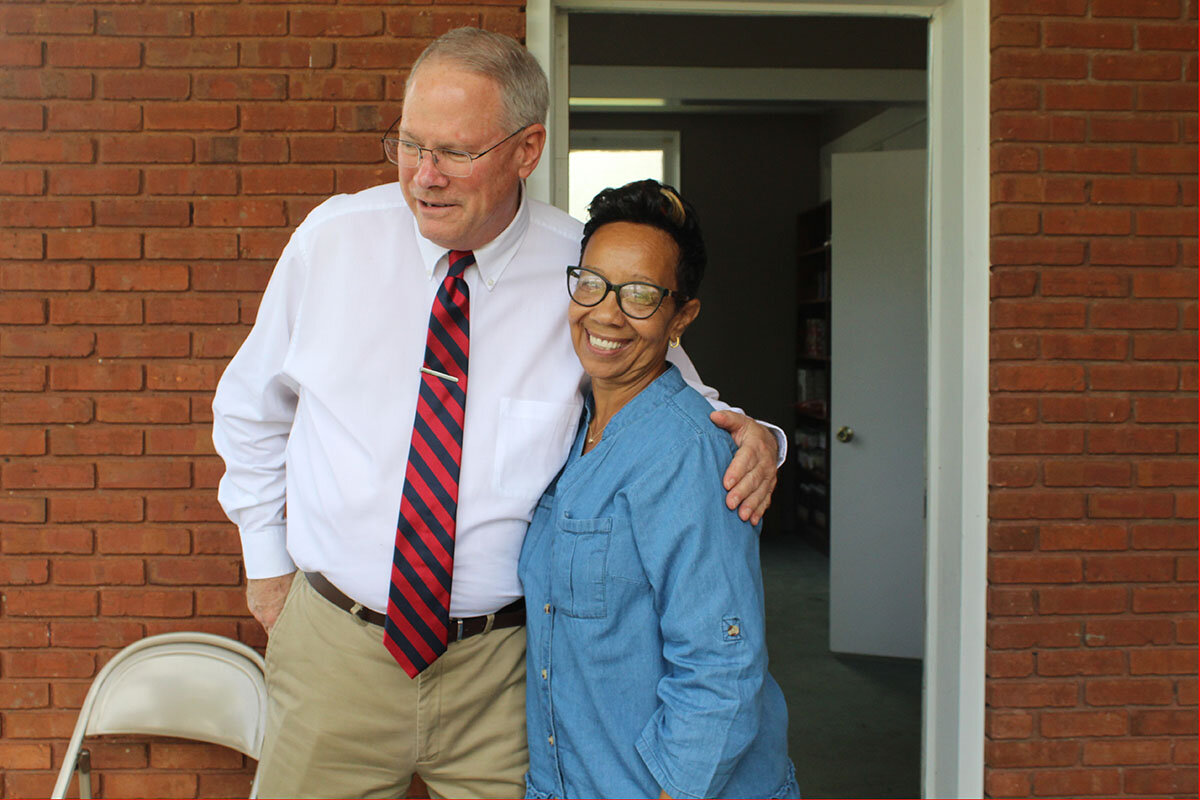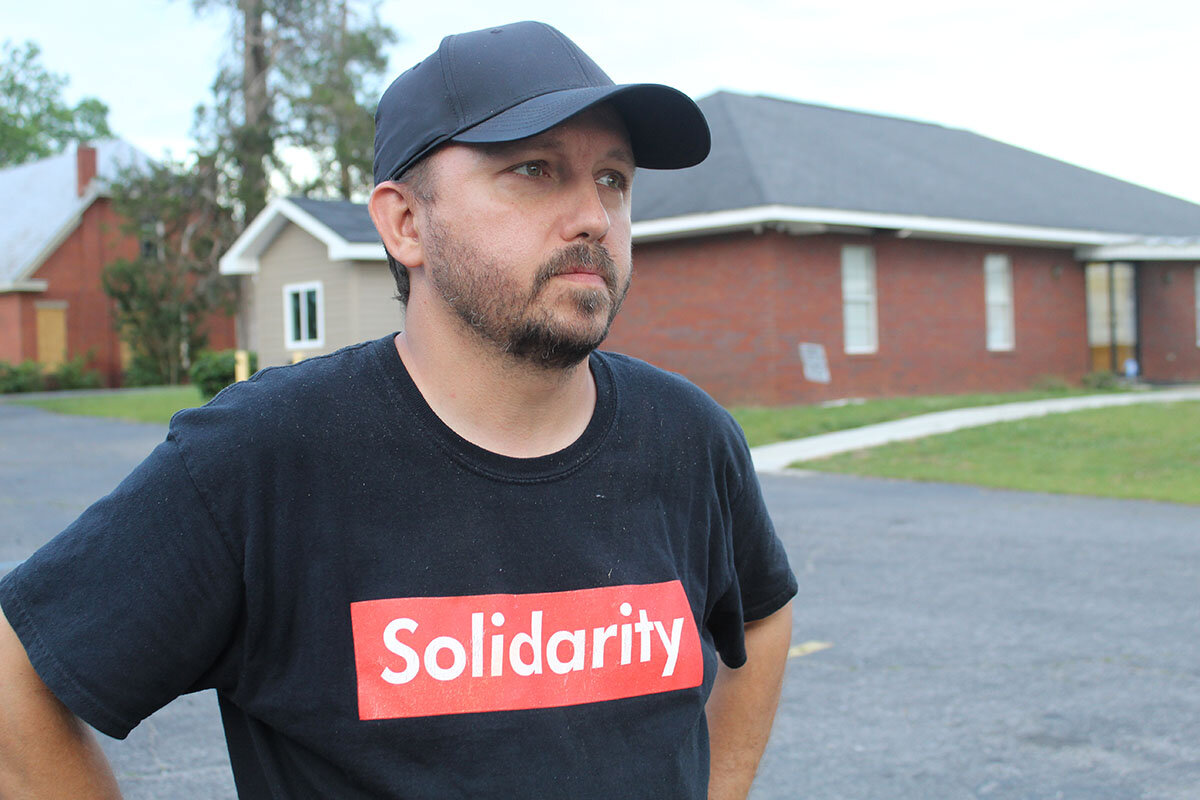A ray of orange light shoots through a hail-size hole in the stained-glass window of what was once a church. On this evening, some of the lightbulbs are broken, and a folding table covered with a white sheet passes as a dais.
This is the new Town Hall complex of Camp Hill, Alabama, and Mayor Messiah Williams-Cole would like to make sure it stands for something. But for a predominantly Black town of 1,000 people struggling through grief, that has proven more difficult than he expected.
Four miles away on April 15, many Camp Hill kids were at a Sweet 16 party when six teens from another town swept in and started firing. More than two dozen teenagers were injured, including two of Mr. Williams-Cole’s cousins. Four died, and several others were paralyzed. Five defendants – all between the ages of 16 and 20 – were indicted May 22 by a grand jury on charges of reckless murder and assault. The case of a sixth defendant, age 15, is being handled by juvenile courts.
Seeking some small measure of healing, Mr. Williams-Cole had an idea: to rename the new Town Hall complex in honor of one of those slain, football star Philstavious “Phil” Dowdell. But the proposal has become an unexpected flashpoint, throwing Camp Hill headlong into fraught national conversations about gun violence, racism, and how America talks about its past.
At a time when guns are the No. 1 cause of death for children and teenagers in the United States, how these victims are honored and remembered points to deep divisions and differences. While the nation universally mourns the victims of high-profile mass shootings, the vast majority of gun violence – and mass shootings – is largely ignored, even accepted.
How much is race a part of that calculus? And what is the best path forward? The national conversation has found no clear answers, yet Camp Hill must now attempt to find its own. It is a monumental task for the 23-year-old mayor, a law student who was elected two years ago and tasked with restoring Camp Hill after decades of decline. How can the town work through its grief and confront a national scourge of gun violence?
Now, all these challenges have become wrapped up in the naming of a local building.
“A lot of the problems are our own fault, and that is something we have to address,” says Mr. Williams-Cole. “But my point is that ... five gunshots is what separated Phil from becoming everything I became, or LeBron James or Oprah. What people don’t want to confront is that the American normal is not normal.”
Mass shootings vs. drive-bys
Earlier this month, when the mayor made his proposal, several members of the Camp Hill Town Council objected. Councilor Juanita Woody says Camp Hill has many people from the past and present deserving of such an honor. “It doesn’t feel right to leave all those people out,” she says.
Others around town cast the debate in more pointed terms. “The argument against naming the complex after the victims seems to be: All these people did was get shot. What was their accomplishment? Do they deserve it?” says Camp Hill resident Dean Bonner.
The issue of how mass shootings are seen goes well beyond Camp Hill. While some white residents were among the victims in Dadeville, a majority are Black, and all of those arrested are Black. According to the way society talks about violence, such shootings among minority groups can be played down or ignored – less deserving of national attention, says Robert White, a humanities professor at Alabama State University.
“White men commit mass shootings, and Black men commit drive-bys,” says Professor White, a native of Tallapoosa County, which includes Camp Hill. “Well, a drive-by is a mass shooting. The major distinction is who the victims are and who the offenders are. These things fit into different paradigms ... that propagandists use.”
These distinctions in how society categorizes acts of violence are coming under increasing scrutiny not only here, but nationwide.
Delaney Tarr, a survivor of the Parkland, Florida, shooting in 2018, says the biggest mistake she and other white, middle-class activists made was to focus on school shootings when far more people are affected by one-on-one gun violence and urban, multi-victim shootouts. Regardless of what form gun violence takes, the impact on families and communities is the same.
“We had to expand our view of [gun violence] pretty quickly, because people of color from marginalized communities, especially, called us in and said, ‘The policies that you’re advocating for aren’t going to help us,’” says Ms. Tarr. “The solution is not going to be calling the cops; the solution is not going to be banning an assault weapon. That’s not the cause of it.”
Camp Hill resident Jesse Francis, whose stepson was paralyzed by a bullet, has listened to the local discussions around naming the new Town Hall complex. But to him, the questions of motive and merit seem beside the point.
“This was the first party that a lot of these kids had gone to,” he says. “They had nothing to do with the shooters. They were dancing and having a good time, and now their lives are changed forever. To me, there’s nothing else to talk about. That’s a mass shooting.”
Hail, then bullets
The shooting was not the only misfortune to hit Camp Hill in recent months. It came weeks after a devastating hail storm pierced roofs and destroyed nearly half the town’s cars. When the town applied for federal assistance, the request was denied. An appeal, too, was denied.
Without outside help, a two-person county emergency management office and an all-volunteer force built a case file of about 400 damaged properties. Now residents are working to scrape together money to get temporary housing for some victims.
Through the twin disasters, Camp Hill has pulled together, rediscovering a sense of purpose and determination, says the mayor. “The outpouring of support has been enormous.”
Like several of the Camp Hill teens killed or injured, Kendarrius Heard, Mr. Francis’ stepson, was an athlete, headed to college on a scholarship. Kendarrius remained in the hospital for a month, returning home in late May. But the trailer where he lived with Mr. Francis and his mom became unlivable after the hail storm. So supporters gathered over several days to build a wheelchair ramp at his grandparents’ house.
Despite concerns from doctors that Kendarrius would never walk again, Mr. Francis says the teen has been in good spirits from all the support. He has regained some feeling in one of his legs, which Mr. Francis credits to his fighting spirit and community prayers.
On a recent day in May, GOP state Rep. Ed Oliver of nearby Dadeville – where the shooting took place – is here to discuss the town’s next moves after the two disasters. He is part of a small delegation, including two staffers from Republican Sen. Tommy Tuberville’s office, to assess what the town needs after both disasters.
He’s greeted warmly by Ms. Woody, the Camp Hill councilor. Their families go back decades. Mr. Oliver’s father, a longtime lawyer, at one point helped keep Ms. Woody’s brother out of jail. Ms. Woody’s family has long used the Oliver law firm to take care of their legal matters, from deeds to wills.
During the visit, talk turns to a bill Mr. Oliver has written, which would ban the teaching of “divisive concepts” in Alabama. Examples include critical race theory, commonly taught in law schools, with its arguments that the United States continues to be fundamentally shaped by white supremacy – seen in laws and norms that perpetuate racism in American institutions.
For Mr. Oliver, a page for former Alabama Gov. George Wallace at the 1976 Democratic presidential convention, the bill is a crucial part of the solution. He says it is impossible to move forward together on difficult issues like gun violence if society is always digging into the past to find points of contention. Pointing to an erosion of what he calls “patriarchal homes” and respect for authority, he says the country can’t “go forward if we keep pointing fingers at each other and finding reasons to make us different.”
The Dadeville shootings, he says, are “a report card on what we’re doing with our kids, and it has as much to do with parents as it does kids.”
But as Mr. Oliver steps away, Ms. Woody, who is Black, shares her own thoughts on the way forward.
“My great-great-grandfather was a slave driver,” she says. “If we ban talking about the past, how can we be sure we don’t repeat it?”
A town “wrapped in amber”
Around town, many agree with her.
Camp Hill has long served as a stage for Black Americans’ often-violent struggle for rights, recognition, and equal treatment.
Past residents include Ned Cobb, a former sharecropper whose reflections in the 1974 book “All God’s Dangers” helped America understand the peculiar and dangerous dynamics of race in the Deep South. Armed conflicts between sharecroppers and Jim Crow authorities here in the 1930s led directly to key provisions in the New Deal that improved prospects for Black citizens nationwide. After writing “To Kill a Mockingbird,” author Harper Lee spent months in the area researching a potential true-crime novel about the sensational murder of a preacher at a funeral home.
To many, past and present are too intertwined to ignore.
“This town was wrapped in amber,” says Warren Tidwell, who has studied Camp Hill as head of a local nongovernmental organization. “It has now been galvanized” to find answers.
Like Mr. Oliver, Alabama State’s Professor White wants to talk about what he sees as abandonment of children – especially Black boys – by parents and society. But he says it will be tougher if Alabama bans conversation on uncomfortable subjects.
As an example of the challenges Black youth face, Professor White recounts the scene at a recent youth flag football game in Montgomery, Alabama. Also a pastor, he asked the players carrying weapons to lay them in the grass. About 20 did.
In Camp Hill, residents cite another example: Most of the teens arrested for the Sweet 16 shooting traveled from Tuskegee, an hour away, where the violent crime rate is nearly twice the national average.
Historical patterns of discrimination certainly aren’t the only cause of these problems, but they are an element, many here say. And how can they be addressed if they can’t be discussed?
Getting to the bottom of these patterns of violence doesn’t mean closing off conversations but opening them up, Professor White says. The goal of efforts to ban discussion of divisive topics, he suggests, is “to make dialogue state property ... to prevent the conversations from taking place, to control the policies. In some ways, it’s ridiculous. But if I was standing on as shaky ground as they are, I would ban conversations, too.”
Understanding what’s next requires a sense of clarity, adds Mr. Williams-Cole. Naming the Town Hall complex after the victims is a matter of moral certitude, he says.
In the end, the Town Council tabled the mayor’s resolution. A compromise might include naming one of the complex’s several buildings.
Mr. Williams-Cole vows to press on: “What I’m trying to do is take that support and make it mean something for the town and for its people – especially those who lost someone they loved.”









